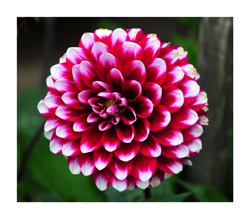
- Getting Started
- Location
- Soil
- Planting Procedure
- Rooting Cuttings
- Staking
- Fertilization
- Watering
- Disbudding and Pinching
- Digging Tubers
- Dividing Tubers
- Cutting Flowers
Dahlias are among the most spectacular flowers you can grow in your garden. Hundreds of varieties are available, with flower sizes ranging from 1 to 14 inches in diameter. Almost any color except true blue can be produced in Georgia.
In exchange for their beauty, dahlias require dedicated care. Most of them need special soil preparation, staking, watering during dry periods, disbudding and a strict insect control program.
Dahlias grow to perfection in the cool, moist summers of the north Georgia mountains. They are also well adapted to the state?s Piedmont area. Dahlias are more difficult to grow in the Coastal Plain area because of its high summer temperatures, but you can expect good flowers here, especially during cool, cloudy periods.
Getting Started
Named dahlia varieties are usually bought as tubers, which are simply enlarged roots. You have a better chance of good results if you buy named varieties instead of those labeled only by color.
Tubers are available in late winter and spring. Most dahlia authorities, however, are in no hurry to plant tubers. They know that the most beautiful flowers come from late plantings that flower at their peak in September and October. Tubers are often planted in April in south Georgia and May in the northern half of the state. June plantings often give the most perfect fall flowers. If tubers are planted early, cuttings can be taken from them in May to produce a late-flowering crop.
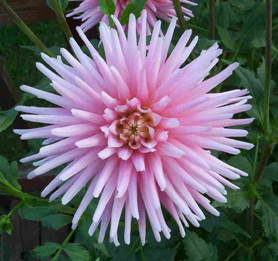
Location
Dahlias thrive in the sun. Place them so they get at least a half day of direct sunlight. They seldom do well in heavy shade or in competition with trees. The location should also have well-drained soil ? dahlias will not grow well in areas where water stands for any length of time.
Soil
The top growth of dahlias is in direct proportion to the extent of the root system. A good root system can be obtained only by proper soil preparation. This means digging a large hole ? 24 inches wide and 18 inches deep is a good goal.
The ideal soil is loose and crumbly, holds moisture well and provides good aeration. Most soils fall short in all these characteristics, but a desirable soil for dahlias can be created easily by incorporating organic matter in the soil removed from digging the hole. The old standby organic matter is well-rotted cow manure. If this is not available, materials such as peat moss, pine bark or decomposed leaf mold are acceptable substitutes. Mix 1/3 organic matter with 2/3 soil. If your soil is on the acid side, add a cup of agricultural lime to the mixture.
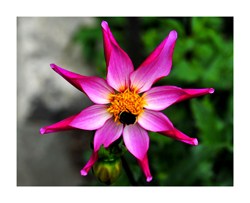
Planting Procedure
If you are short on time, plant the tubers in pots or gallon cans and transfer them to the ground when you have time to prepare the soil properly. The tubers are usually placed 4 to 6 inches deep. Be generous in spacing. Most varieties need to be at least 3 to 4 feet apart.
Rooting Cuttings
Allow only one shoot to develop from the tuber. The other “slips” can be removed and rooted easily if you want additional plants. To do this, wait until the growth is approximately 10 to 12 inches high. Pull the soil back from around the underground stems and cut off the extra shoots near where they emerge from the tuber. The cuttings should develop sufficient roots for transplanting in two to three weeks. After transplanting, shade the young plants for a week with newspaper or similar material. Water carefully during this period.
Staking
You?ll be in for a big disappointment if you don?t stake your dahlias. Since most of the better varieties grow tall, they cannot support themselves when they reach maturity. A heavy wind or rain will destroy them.
Stakes need to be at least 6 feet long to be useful. Drive them about 1 foot into the ground. The easiest time to do this is at planting time. Some growers prefer two stakes about 18 inches apart to support each plant.
When the plants are about 1 foot tall, tie them to the stakes with soft string or cloth strips. Repeat about once a month as the plant grows taller. The limbs that bear the flowers especially need support.
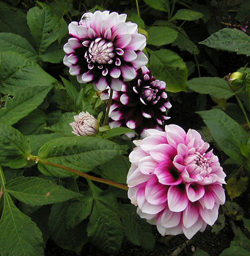
Fertilization
If cow manure is used as a soil amendment, it is not necessary to add fertilizer at planting time. If peat moss, pine bark, leaf mold or similar materials are used, about ¼ cup of balanced fertilizer per plant should be adequate when preparing the soil. Each month thereafter, fertilize the dahlias with 1/8 to 1/4 cup per plant of balanced fertilizer. When the plants are large (5 to 6 feet), increase the rate to 1/2 cup per plant. An analysis with a 1-1-1 ratio such as 8-8-8 is good. Most other fertilizer analyses that give satisfactory results in vegetable and flower gardens can be used successfully for dahlias.
Watering
Dahlia plants are composed mostly of water. Don?t expect good flowers unless you plan to water during dry periods. Give the plants a good soaking once a week. Light surface applications will not do the job.
To conserve the water you apply, mulch the plants. A wide variety of materials can be used successfully, including pine straw, grass clippings, pine bark and black mulching plastic. If a mulch is not used, watering twice a week during dry periods will be desirable.
Disbudding and Pinching
When the young plant has produced three or four pairs of leaves, pinch out the top. This is done to cause the plant to produce side limbs.
Disbudding is another vital cultural practice. It involves nothing more than removing some of the flower and growth buds on each flower stem. Beginners are sometimes reluctant to do this. Unless dahlias are disbudded, however, they will not produce large, perfectly formed flowers on long stems.
When the flower buds of the tip cluster are about the size of peas, remove all but one. At the same time, pinch out the small, tender growth buds in the leaf axils of the top set of leaves on the stem. You might also need to do the same for the buds coming from the base of the next set of leaves if the variety produces short stems.
Remember that dahlias produce more flower buds than the plant can supply with food. Disbudding is necessary to channel sufficient food to a select number of flowers.
Digging Tubers
Overwintering tubers of good dahlia varieties in the ground is an unwise practice. A severe winter may kill them all. Most dahlia growers dig the tubers after the first frost.
Careless digging can destroy the tubers. Note in Figure 1 that the “eyes” or growth buds occur only in the area connecting with the underground stem. If the tubers are pulled off or if they break off, the buds are almost always lost and the tubers are worthless.
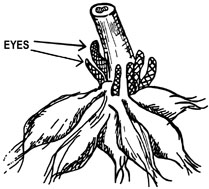 Figure 1. The "eyes" or growth buds occur only in the area connecting with the underground stem. If the tubers are pulled off or if they break off, the buds are almost always lost and the tubers are worthless.
Figure 1. The "eyes" or growth buds occur only in the area connecting with the underground stem. If the tubers are pulled off or if they break off, the buds are almost always lost and the tubers are worthless.Allow the dug tubers to dry for a day before you store them. A 35 degrees F to 50 degrees F storage temperature is desirable. If the storage area is moist, store the clumps without packing. Many growers store them in large boxes and cover the clumps with dry vermiculite or similar dry materials.
Dividing Tubers
A single tuber planted in the spring will multiply into a number of tubers by late summer. If the clump is not divided, many stems will emerge the following spring. This is not desirable. The most vigorous plants with the best flowers come from individual plants and not from clumps. For this reason, divide dahlia tubers each year. This is done by carefully cutting the tubers apart with a sharp knife as illustrated in Figure 2. Since each tuber must have an eye or growth bud, many dahlia growers delay dividing until early spring when the buds have swollen and can easily be seen.
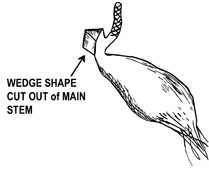 Figure 2. A cluster of tubers can be separated by cutting with a sharp knife. Be sure each tuber contains a portion of the underground stem with an eye.
Figure 2. A cluster of tubers can be separated by cutting with a sharp knife. Be sure each tuber contains a portion of the underground stem with an eye.Cutting Flowers
To prevent wilting, cut only in the early morning or late afternoon. Place flowers in warm water immediately after cutting. The temperature should be warm but not uncomfortably hot to the touch. Cut flowers only after they open to mature size ? they will not open after cutting. Also, they are less likely to wilt after reaching maturity
Status and Revision History
In Review for Major Revisions on Feb 24, 2009
Published with Minor Revisions on Jan 31, 2012
Published with Full Review on Jan 23, 2015
Published with Full Review on Dec 16, 2022
